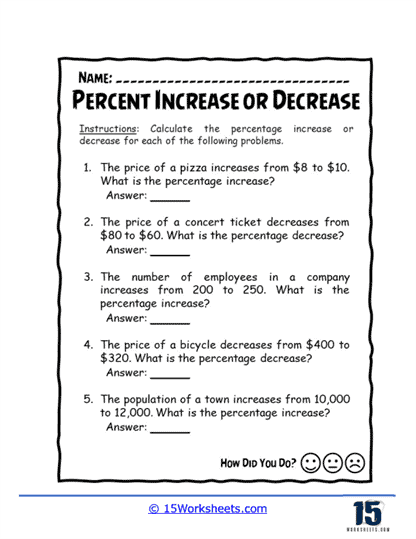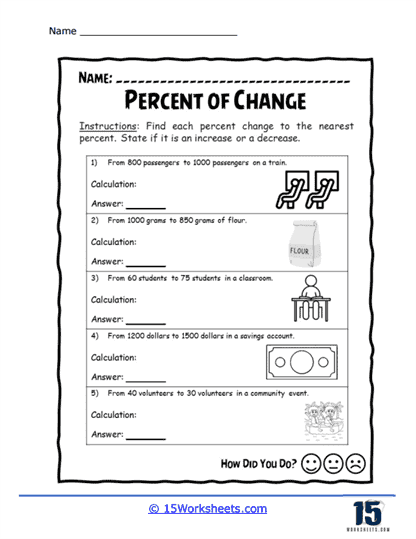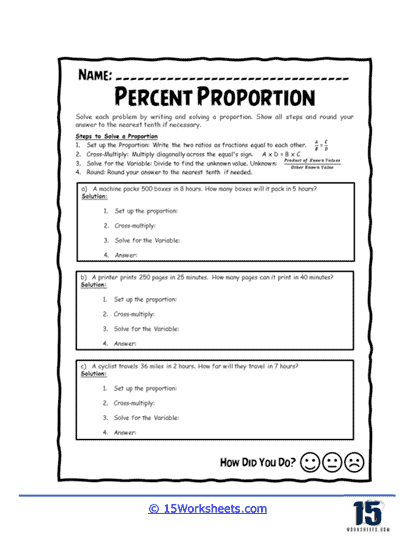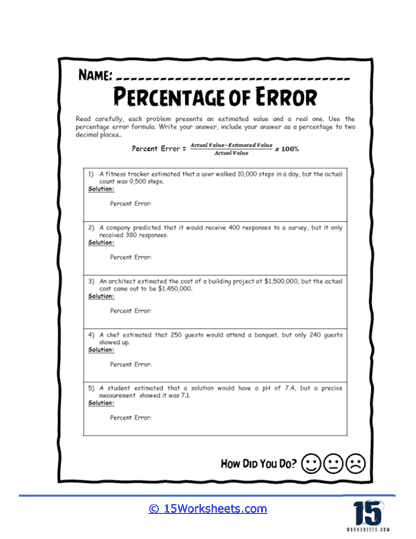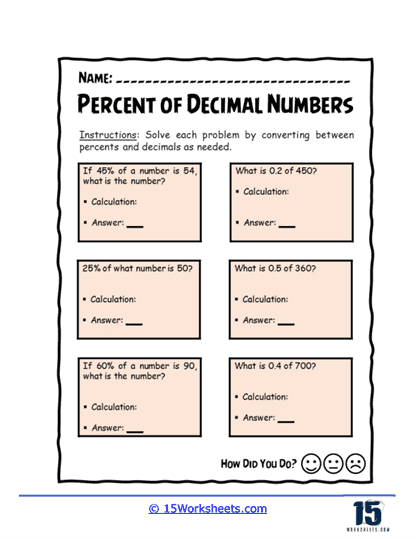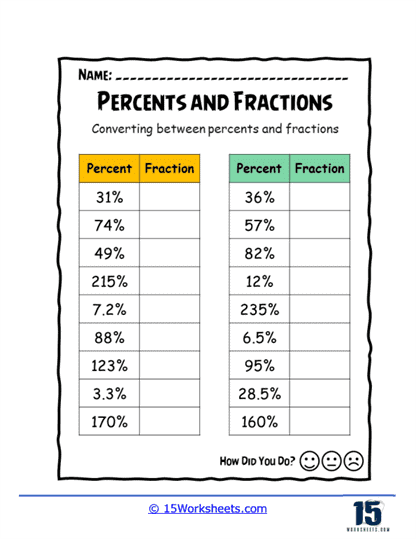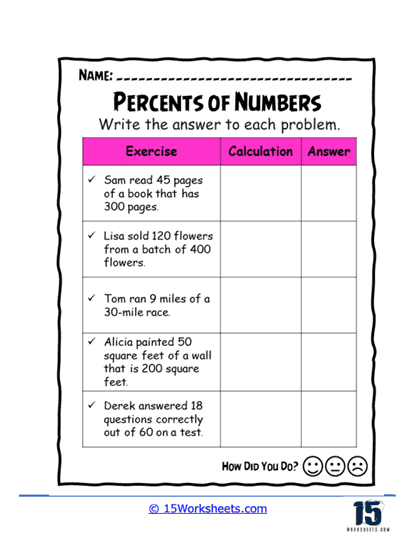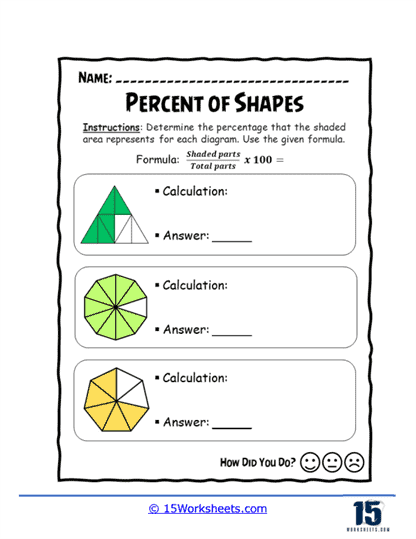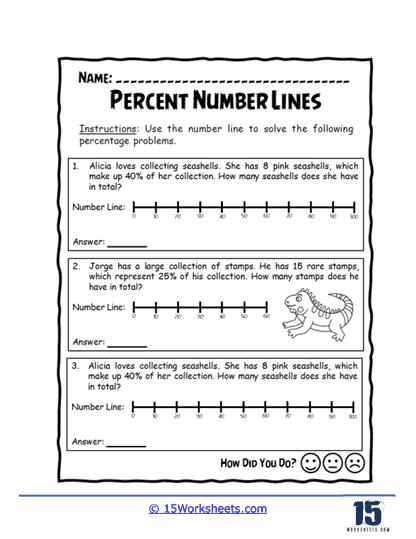Percentages Worksheets
Related Worksheets
About These 15 Worksheets
These worksheets include a variety of exercises designed to build proficiency in calculating percentages, understanding their relationship with fractions and decimals, and applying these skills to real-world scenarios. Each type of exercise on a percentages worksheet serves to develop specific math skills, guiding students through the process of learning percentages in a structured and comprehensive manner.
One of the primary types of exercises found on percentages worksheets is calculating the percentage of a number. These problems might ask students to determine what percentage a certain number is of another number, such as finding what percent 25 is of 200. This type of problem reinforces students’ understanding of the basic percentage formula, where the percentage is calculated as the part divided by the whole, multiplied by 100. By practicing these calculations, students learn how to break down problems into manageable steps, enhancing their ability to tackle percentage-related questions with confidence.
Another common exercise on these worksheets involves converting between percentages, fractions, and decimals. For instance, students might be asked to convert a fraction like 3/4 into a percentage or a decimal like 0.25 into a fraction. This type of exercise helps students understand the interchangeable nature of these three representations of numbers. By repeatedly converting between these forms, students develop a deeper understanding of the relationships between them, making it easier to switch between percentages, fractions, and decimals in different contexts. This skill is particularly useful in real-life situations, such as comparing discounts, interest rates, or statistical data.
Word problems involving percentages are another key component of percentages worksheets. These problems present students with real-world scenarios where they must apply their knowledge of percentages to find solutions. For example, a word problem might describe a situation where a store is offering a 20% discount on a product, and the student needs to calculate the sale price. Such problems not only test students’ ability to calculate percentages but also require them to interpret and analyze information, making the connection between math and everyday life. This type of exercise is crucial for developing critical thinking skills and the ability to apply mathematical concepts outside of the classroom.
Percentage increase and decrease problems are also commonly found on these worksheets. These exercises ask students to calculate how much a number has increased or decreased by a certain percentage. For instance, students might be asked to determine the new price of an item after a 15% increase or find the original price of a product before a 25% decrease. These problems help students understand how percentages are used in the context of growth and reduction, such as in financial situations, population studies, or price adjustments. By working through these problems, students learn to calculate percentage changes and understand the significance of these changes in practical scenarios.
In addition to straightforward calculations, percentages worksheets often include exercises on finding the percentage of a part relative to a whole. These problems might involve questions like “What percentage of the class scored above 80% on the test?” or “If 150 out of 500 people attended the event, what percentage does that represent?” These exercises reinforce the concept of ratios and proportions, teaching students how to express one quantity as a percentage of another. Understanding this concept is important for analyzing data, comparing quantities, and making informed decisions based on numerical information.
Some percentages worksheets also include problems that require students to reverse the percentage operation, such as finding the original number before a percentage was applied. For example, a problem might state that a final price of $120 reflects a 20% discount and ask students to calculate the original price. These reverse percentage problems challenge students to think critically and apply their understanding of percentage calculations in a more complex way. This type of problem-solving is valuable in real-world situations, such as calculating the original price of an item after a discount or determining the initial population size before a percentage increase or decrease.
These worksheets will often feature exercises on percentage comparisons, where students are asked to compare different percentages and determine which is larger or smaller. For example, students might be given two percentages and asked to identify which represents a greater quantity when applied to the same base number. These comparison problems help students develop a better understanding of the relative size of percentages and the impact they have on different quantities. This skill is particularly useful when analyzing data, such as comparing rates of change, growth, or other percentage-based statistics.
Another important type of exercise in this collection involves solving problems related to compound percentages. These problems require students to apply multiple percentage changes to a single quantity, such as calculating the final amount after a series of percentage increases and decreases. For example, a problem might ask students to find the final price of a product after a 10% discount followed by a 5% tax. Compound percentage problems help students develop their ability to perform multi-step calculations and understand the cumulative effect of multiple percentage changes. This skill is essential for understanding more complex financial situations, such as calculating compound interest or determining the overall impact of multiple discounts or fees.
These worksheets also often include exercises that involve interpreting percentage data presented in charts or tables. These problems might ask students to analyze a pie chart showing the percentage distribution of a budget or to read a table displaying percentage changes in population over time. Interpreting percentage data from visual representations helps students develop the ability to analyze and understand information presented in different formats. This skill is particularly important in fields such as economics, business, and social sciences, where data analysis is a key component of decision-making.
In addition to these standard exercises, some of the worksheets include more advanced problems that require students to apply their percentage skills in unfamiliar or challenging contexts. For example, students might be asked to solve problems involving percentage error, where they calculate the difference between an estimated value and the actual value as a percentage of the actual value. These advanced problems push students to think creatively and apply their knowledge of percentages in new ways, helping them develop a deeper and more flexible understanding of the concept.
Percentages In Our Daily Lives
Percentages play a significant role in our daily lives, often influencing the decisions we make, the information we interpret, and the way we understand the world around us. They are used in various aspects of everyday activities, from financial decisions to understanding health information, making them an essential concept for navigating modern life.
One of the most common uses of percentages in daily life is in financial transactions and budgeting. When shopping, for example, we frequently encounter discounts expressed as percentages, such as “20% off” sales. Understanding how to calculate the final price after a discount helps us make informed purchasing decisions. Similarly, percentages are used to calculate taxes, whether it’s sales tax added at the checkout or income tax deducted from our earnings. Knowing how these percentages affect our total spending or take-home pay is crucial for effective financial planning.
Percentages are also central to understanding and managing credit and loans. Interest rates, which are usually expressed as percentages, determine how much extra we pay when borrowing money through credit cards, mortgages, or other loans. Understanding these percentages helps us evaluate the true cost of borrowing and compare different financial products. In addition, percentages are used to calculate the returns on investments, whether it’s the interest earned in a savings account or the percentage growth of a stock portfolio.
In health and fitness, percentages are often used to measure progress and set goals. For instance, body fat percentage is a common metric for assessing fitness levels, while nutrition labels on food products express nutrient content as a percentage of the recommended daily value. Understanding these percentages helps us make healthier choices, monitor our dietary intake, and track fitness goals over time.
Percentages are also vital in understanding statistics and data presented in the news, reports, and studies. Whether it’s the unemployment rate, which reflects the percentage of people without jobs, or election results expressed as a percentage of votes, these figures help us make sense of complex information. In public health, percentages are used to report vaccination rates, infection rates, and other critical health statistics, helping us understand the impact of diseases and the effectiveness of public health measures.

